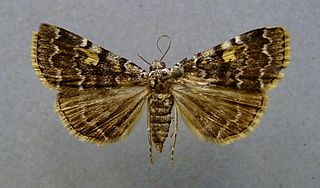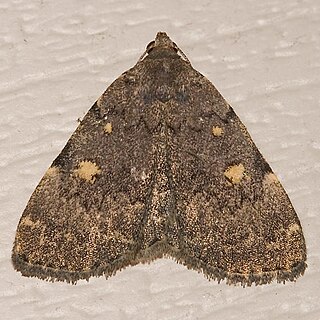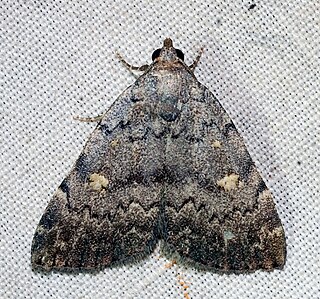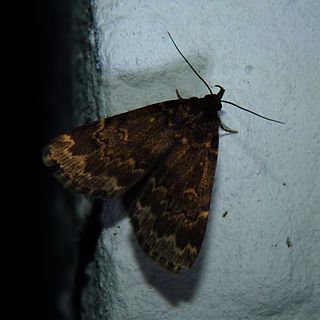
The Herminiinae are a subfamily of moths in the family Erebidae. The members of the subfamily are called litter moths because the caterpillars of most members feed on dead leaves of plants, though others feed on living leaves.

Idia is a genus of litter moths of the family Erebidae first described by Jacob Hübner in 1813.

Eugonobapta is a monotypic moth genus in the family Geometridae described by Warren in 1894. Its only species, Eugonobapta nivosaria, the snowy geometer, was first described by Achille Guenée in 1857. It is found in North America from Manitoba to New Brunswick, south to North Carolina and Tennessee.

Idia calvaria is a species of litter moth of the family Erebidae. It is found in Central France and northern and central Central Europe, but mostly in the surroundings of the Mediterranean Sea. It is also present in Turkey, the Caucasus and Anatolia.

Idia aemula, the common idia, powdered snout or waved tabby, is a litter moth of the family Erebidae. The species was first described by Jacob Hübner in 1813. It is found from Canada south to Florida and Texas. It has been reported in the Palearctic.

Idia concisa, the pale-winged idia is a litter moth of the family Erebidae. The species was first described by William Trowbridge Merrifield Forbes in 1954. It is widespread across much of eastern North America.

Idia lubricalis, the glossy black idia, is a litter moth of the family Erebidae. The species was first described by Carl Geyer in 1832. It is found from Canada south to Florida and Texas in deciduous forests.
Idia occidentalis is a species of litter moth of the family Erebidae first described by Smith in 1884. It is found in North America from southern Alberta and British Columbia, south to Colorado, Arizona and California.

Idia americalis, the American idia or American snout, is a litter moth of the family Erebidae. The species was first described by Achille Guenée in 1854. It is commonly found in moist forests in North America, ranging from southern Canada to Florida and Texas. It is nocturnal and can be lured by sugar baits and light traps.

Idia diminuendis, the orange-spotted idia, is a litter moth of the family Erebidae. The species was first described by William Barnes and James Halliday McDunnough in 1918. It is found in North America from Wisconsin to Nova Scotia, south to Florida and Texas.
Idia julia, or Julia's idia, is a litter moth of the family Erebidae. The species was first described by William Barnes and James Halliday McDunnough in 1918. It is found from southern Canada south to Georgia and Texas.

Idia rotundalis, the chocolate idia or rotund idia moth, is a litter moth of the family Erebidae. The species was first described by Francis Walker in 1866. It is found from southern Canada to Florida and Texas.
Idia scobialis, the smoky idia, is a litter moth of the family Erebidae. The species was first described by Augustus Radcliffe Grote in 1880. It is found in North America from Michigan, southern Quebec and Maine, south to Florida and at least Kentucky.
Idia denticulalis, the toothed idia, is a litter moth of the family Erebidae. The species was first described by Leon F. Harvey in 1875. It is found in Quebec, Canada, and the US from Wisconsin to New England, south to Alabama and Texas.
Idia laurentii, the laurentine idia, is a litter moth of the family Erebidae. The species was first described by J. B. Smith in 1893. It is found in the US from central New York, south to the mountains of North Carolina.
Idia majoralis, the greater idia, is a litter moth of the family Erebidae. The species was first described by J. B. Smith in 1895. It is found in Canada from Ontario and Quebec, south into the United States, where it has been recorded from Illinois, Wisconsin and Missouri.
Idia terrebralis is a species of litter moth of the family Erebidae first described by William Barnes and James Halliday McDunnough in 1912. It is found in North America, including Illinois.
Idia parvulalis is a species of litter moth of the family Erebidae first described by William Barnes and James Halliday McDunnough in 1911. It is found in North America, including its type location, the Santa Catalina Mountains in south-eastern Arizona.
Idia immaculalis, the immaculate idia, is a litter moth of the family Erebidae. The species was first described by George Duryea Hulst in 1886. It is found in North America from at least California, north and east across Montana to southern Alberta and Saskatchewan.

Hypotrix ferricola is a moth of the family Noctuidae first described by Smith in 1905. It is found in southern North America from south-eastern Arizona, south-western New Mexico and northern Mexico.










